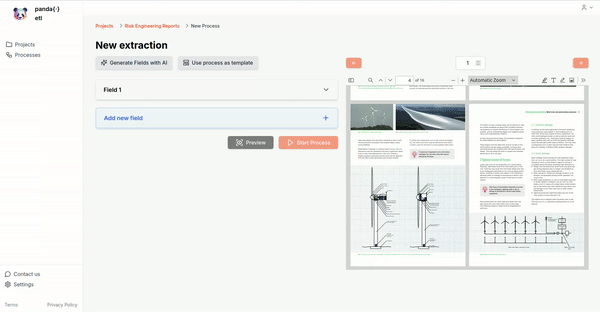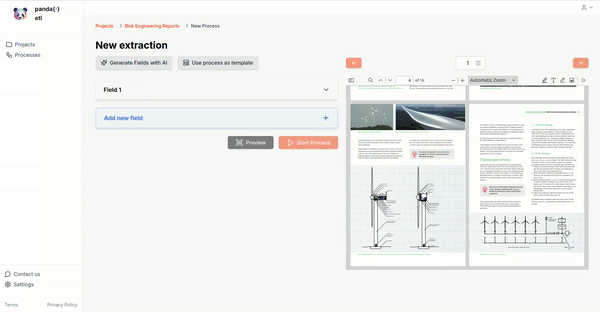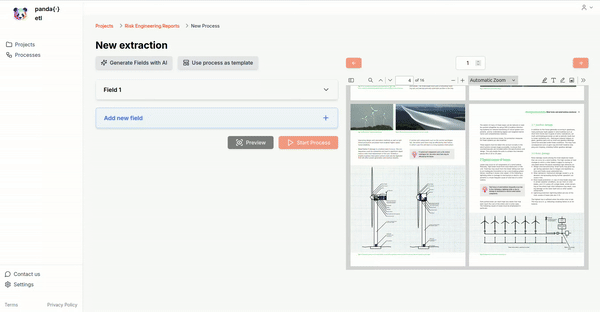Energy insurance: faster underwriting, no-code
Extract machinery models and their conditions from risk engineering reports in minutes, not hours.

- A coder in underwriter's shoes: the spark behind the underwriting platform
- Introducing a no-code solution for energy insurance underwriting experts
- The traditional underwriting process: a time-consuming tango
- When AI enters the dance floor: promises, pitfalls and humans
- A new horizon: 10X faster underwriting and risk engineering
A coder in underwriter's shoes: the spark behind the underwriting platform
It all started when I joined an AI consultancy firm and one of the clients, Aegis, a major player in the energy insurance sector, came to us with a challenge that would change the trajectory of my career. Their problem was straightforward yet daunting: how to efficiently process and analyze the complex risk engineering reports for energy production machinery.
Here I was, a linguistics expert with NLP skills, suddenly needing to become fluent in the language of machinery and wind energy. As I delved into the project, I quickly realized the enormity of the task at hand. These reports were not just documents; they were veritable tomes, hundreds of pages long, filled with technical jargon and critical details about turbine models and their conditions.
I felt the pain daily experienced by underwriters: extracting relevant information from these reports was like finding a needle in a haystack – if the haystack was the size of a small country. And extracting the right information was critical in order to identify and classify risks.
Introducing a no-code solution for energy insurance underwriting experts
Some time passed since taking up Aegis challenge and today I'm proud to say that - at Sinaptik - we've developed a no-code platform that empowers energy insurance experts to manage and analyze risk engineering reports with unprecedented efficiency, making the underwriting process 10 times faster.
Some of the key features of this solution include:
- Intuitive interface to upload, navigate, and analyze lengthy risk engineering reports
- Ability to extract specific machinery models and conditions using plain English
- Transparent, context-aware data extraction that allows underwriters to verify accuracy
- Automatic risk identification and labeling on top of the extracted data
When we set up on developing this platform we grounded its foundations in reality and experience, aware of both the traditional energy insurance underwriting process, and the promises and pitfalls of AI.


Share your biggest risk engineering struggles with us!
The traditional underwriting process: a time-consuming tango
In the world of energy insurance, the dance between risk engineers and underwriters has long been a complex and time-consuming affair. The typical scenario unfolds like this: engineers meticulously craft detailed reports, often hundreds of pages long, filled with technical specifications and assessments of energy production machinery. Then, underwriters step in, tasked with the critical job of identifying and evaluating risks based on these extensive documents.
The process is as manual as it is painstaking. Underwriters spend countless hours reading through these reports, assessing each detail to make informed decisions about risk and coverage. It's a necessary but incredibly time-intensive process that has been the industry standard for years.

Curious, talk with the makers!
When AI enters the dance floor: promises, pitfalls and humans
As with many industries, artificial intelligence seems like a promising solution to streamline the underwriting process. However, the reality is more complicated, with each AI approach presenting its own set of challenges.
Rule-based models, while straightforward to implement, often struggle with recall. They simply can't account for the vast complexity and variability found in detailed engineering reports. These models tend to miss crucial information, making them unreliable for comprehensive risk assessment.
On the other hand, more advanced solutions like Large Language Models (LLMs) present a different problem. While impressive in their ability to process and generate human-like text, these models, when used without proper filtering and control, can introduce dangerous false positives through hallucinations. They might generate plausible-sounding but entirely fictional information – a perilous proposition in an industry where accuracy is paramount. In energy insurance, where a single misinterpreted detail could lead to millions in mispriced risk, such AI-generated fabrications are simply unacceptable.
Beyond these technical challenges lies a fundamental human issue: the communication gap between developers and underwriters. For developers, diving deep into energy insurance terminology is daunting. Conversely, underwriters have little interest in becoming coders overnight. This language barrier often leads to endless meetings and reduced productivity, creating a significant obstacle in implementing effective AI solutions.

Reach out us here to help us further improving the platform!
A new horizon: 10X faster underwriting and risk engineering
Faced with these challenges, we set an ambitious goal: to make energy insurance underwriting and risk engineering ten times faster. It was time for a paradigm shift, one that would bridge the gap between technical capability and industry expertise.

Our solution was designed with a clear user in mind: the energy insurance experts with zero coding skills, allowing them to:
- Manage and dialogue with risk engineering reports: an intuitive drive-like and chat interface to upload and analyze long reports. Ask questions, request summaries, and dive into specific sections with ease.
- Extract machinery models and their conditions by just using words: underwriters ask for specific energy production machinery models and their conditions in plain English, the platform finds them
- Get familiar spreadsheets, context-augmented: transparency is key in insurance. With our solution, underwriters can click on any extracted data point to see it highlighted in its original context within the report. This feature ensures that underwriters can verify the accuracy of the AI's work and make informed decisions.
- Get risk labels, faster: once the platform has made explainable extractions, it can automatically categorize the information based on predefined or custom criteria.
At its core, our platform features a sophisticated, flexible, and modular NLP router that combines a great variety of AI techniques. This approach allows us to tailor the solution to the specific needs of energy insurance underwriting while avoiding the pitfalls of one-size-fits-all AI models.

Book a 15-min call to share insights in the energy insurance underwriting space!
